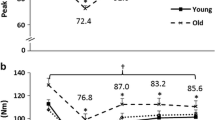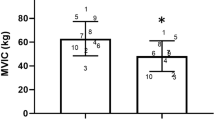Summary
Fractionated resisted and unresisted RT for a knee-extension task was assessed on 12 male subjects over a 10-day treatment period. The first 4 days were baseline days and were designed to stabilize all RT values as well as strength measures. For the next 6 days the subjects were alternately administered isometric and isotonic exercise designed to fatigue the quadriceps musculature. Although significant strength decrements were manifested for both isometric exercise (57%) and isotonic exercise (35%), no changes were shown in the unresisted fractionated RT components. Conversely all resisted RT changes were manifested in the muscular component suggesting a peripheral site for neuromuscular fatigue.
Similar content being viewed by others
References
Barcroft, H., Millen, J. L. E.: The blood flow through muscle during sustained contraction. J. Physiol. (Lond.) 97, 17–31 (1939)
Bigland-Ritchie, B., Hosking, G. P., Jones, D. A.: The site of fatigue in sustained maximal contractions of the quadriceps muscle. J. Physiol. (Lond.) 250, 45–46 (1975)
Clarke, D. H.: The influence on muscular fatigue patterns of the intercontraction rest interval. Med. Sci. Sports 3, 83–88 (1971)
Hayes, K. C.: Effects of fatiguing isometric exercise upon Achilles tendon reflex and plantar flexion reaction time components in man. Europ. J. appl. Physiol. 34, 69–79 (1975)
Keul, J.: Physical activity and metabolism. In: Limiting factors of physical performance (J. Keul, ed.), pp. 1–5. Stuttgart: Thieme 1973
Konorski, J.: The problem of the peripheral control of skilled movements. Int. J. Neurosci. 1, 39–50 (1970)
Kroll, W.: Effects of local muscular fatigue due to isotonic and isometric exercise upon fractionated reaction time components. J. Mot. Behav. 5, 81–93 (1973)
Kroll, W.: Fractionated reaction and reflex time before and after fatiguing isotonic exercise. Med. Sci. Sports 6, 260–266 (1974)
Lagassé, P. P.: Muscle strength: Ipsilateral and contralateral effects of superimposed stretch. Arch. phys. Med. Rehabil. 55, 305–310 (1974)
Lippold, O. C. J., Redfearn, J. W. T., Vuco, J.: The electromyography of fatigue. Ergonomics 3, 121–131 (1960)
Merton, P. A.: Problems of muscular fatigue. Brit. med. Bull. 12, 219–221 (1956)
Morris, A. F.: Myotatic reflex effects on bilateral reciprocal leg strength. Amer. Corr. Ther. J. 28, 24–29 (1974)
Person, R. S.: Rhythmic activity of a group of human motoneurones during voluntary contraction of a muscle. Electroenceph. clin. Neurophysiol. 38, 91–95 (1975)
Petrofsky, J. S., Lind, A. R.: Aging, isometric strength and endurance, and cardiovascular responses to static effort. J. appl. Physiol. 38, 91–95 (1975)
Reid, C.: The mechanism of voluntary muscular fatigue. Quart. J. exp. Physiol. 19, 17–42 (1928)
Royce, J.: Force time characteristics of the exertion and release of hand grip strength under normal and fatigued conditions. Res. Quart. 33, 444–450 (1962)
Schmidt, E. M., Jost, R. G., Davis, K. K.: Plasticity of cortical cell firing patterns after load changes. Brain Res. 73, 540–544 (1974a)
Schmidt, E. M., Jost, R. G., Davis, K. K.: Cortical cell discharge patterns in anticipation of a trained movement. Brain Res. 75, 309–311 (1974b)
Schmidt, E. M., Jost, R. G., Davis, K. K.: Reexamination of the force relationship of cortical cell discharge patterns with conditioned wrist movements. Brain Res. 83, 213–223 (1975)
Sheerer, N., Berger, R. A.: Effects of various levels of fatigue on reaction time and movement time. Amer. Corr. Ther. J. 26, 146–147 (1972)
Simonson, E.: Fundamental processes. In: Physiology of work capacity and fatigue (E. Simonson, ed.), pp. 5–8. Springfield, Ill.: Thomas 1971
Stein, R. B.: Peripheral control of movement. Physiol. Rev. 54, 215–243 (1974)
Weiss, A. D.: The locus of reaction time change with set, motivation, and age. J. Geront. 20, 60–64 (1965)
Author information
Authors and Affiliations
Additional information
The author gratefully acknowledges the help of Dr. W. Kroll of the University of Massachusetts at various stages of this study.
Rights and permissions
About this article
Cite this article
Morris, A.F. Effects of fatiguing isometric and isotonic exercise on resisted and unresisted reaction time components. Europ. J. Appl. Physiol. 37, 1–11 (1977). https://doi.org/10.1007/BF00421593
Received:
Issue Date:
DOI: https://doi.org/10.1007/BF00421593




